Description
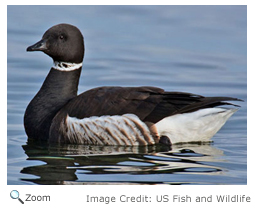 The brant is a small goose. It is about two feet long and its wingspan is about four feet. It has a dark brown or black head, neck, and chest and a white band on its neck. It has a white rump, dark wing feathers, and a black bill, legs, and feet. Its belly is light brown and its back is blackish-brown.
The brant is also known as the brent goose. The brant is a small goose. It is about two feet long and its wingspan is about four feet. It has a dark brown or black head, neck, and chest and a white band on its neck. It has a white rump, dark wing feathers, and a black bill, legs, and feet. Its belly is light brown and its back is blackish-brown.
The brant is also known as the brent goose.
Range 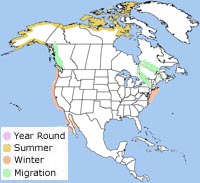 The brant breeds in coastal Alaska and Arctic Canada. It winters along both coasts south to California, the Carolinas, and Mexico. Brants are also found in Europe and Asia. The brant breeds in coastal Alaska and Arctic Canada. It winters along both coasts south to California, the Carolinas, and Mexico. Brants are also found in Europe and Asia.
Habitat 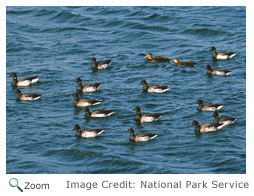 During the breeding season, brants are found in the tundra and on coastal islands in the Arctic. In the winter, they are found in salt marshes and estuaries. During the breeding season, brants are found in the tundra and on coastal islands in the Arctic. In the winter, they are found in salt marshes and estuaries.
DietThe brant eats green plants including eelgrass and sea lettuce. The brant doesn't usually dive for its food, but instead waits for low tide and then pulls the grass up. Sometimes it will pull extra plants up at low tide. When it is high tide, the plants float and the brant eats them.
A large part of the brant's diet is eelgrass. In the 1930s a disease devastated eelgrass and the brant population dropped. The brants that survived switched to sea lettuce. Eelgrass recovered and today the brant population has risen.
| |
Life Cycle 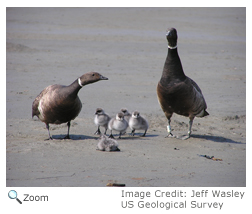 Brants arrive at their breeding grounds, already paired, in early June. Brants nest in colonies in lowland areas of the tundra and prefer small islets in ponds and small lakes. Brants arrive at their breeding grounds, already paired, in early June. Brants nest in colonies in lowland areas of the tundra and prefer small islets in ponds and small lakes.
Female brants lay three to five eggs in a nest of moss, lichen, seaweed, and down in a depression in the ground. When the female leaves the nest to forage, she covers the eggs with down to keep them warm.
The eggs take a little under a month to hatch. The chicks leave the nest and are led to forage for food within a few days of hatching. The chicks fledge in 40-50 days, but they stay with their parents through the winter. Brant pairs usually remain together and return to the same breeding ground year-after-year.
Behavior
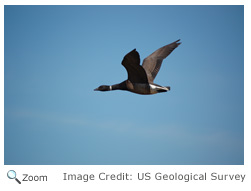 Brants are long distance migrators. Some fly 3,000 miles from their nesting grounds on the coast of Arctic Ocean to the coast of Mexico. Other groups migrate from the Arctic down the Hudson Bay to the Atlantic Coast. Brants are long distance migrators. Some fly 3,000 miles from their nesting grounds on the coast of Arctic Ocean to the coast of Mexico. Other groups migrate from the Arctic down the Hudson Bay to the Atlantic Coast.
Brants don't migrate in V's like Canada geese or straight lines like snow geese. They fly in unorganized groups. They are very vocal when they migrate and make a loud "cronk" sound.
|

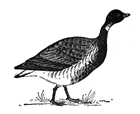

 The brant breeds in coastal Alaska and Arctic Canada. It winters along both coasts south to California, the Carolinas, and Mexico. Brants are also found in Europe and Asia.
The brant breeds in coastal Alaska and Arctic Canada. It winters along both coasts south to California, the Carolinas, and Mexico. Brants are also found in Europe and Asia. 

